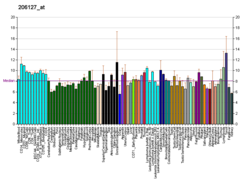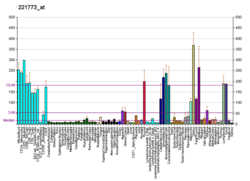ELK3
| ELK3 | |||||||||||||||||||||||||||||||||||||||||||||||||||
|---|---|---|---|---|---|---|---|---|---|---|---|---|---|---|---|---|---|---|---|---|---|---|---|---|---|---|---|---|---|---|---|---|---|---|---|---|---|---|---|---|---|---|---|---|---|---|---|---|---|---|---|
| Identifiers | |||||||||||||||||||||||||||||||||||||||||||||||||||
| Aliases | ELK3, ERP, NET, SAP2, SAP-2, ETS transcription factor, ETS transcription factor ELK3 | ||||||||||||||||||||||||||||||||||||||||||||||||||
| External IDs | OMIM: 600247; MGI: 101762; HomoloGene: 3833; GeneCards: ELK3; OMA:ELK3 - orthologs | ||||||||||||||||||||||||||||||||||||||||||||||||||
| |||||||||||||||||||||||||||||||||||||||||||||||||||
| |||||||||||||||||||||||||||||||||||||||||||||||||||
| |||||||||||||||||||||||||||||||||||||||||||||||||||
| |||||||||||||||||||||||||||||||||||||||||||||||||||
| |||||||||||||||||||||||||||||||||||||||||||||||||||
| Wikidata | |||||||||||||||||||||||||||||||||||||||||||||||||||
| |||||||||||||||||||||||||||||||||||||||||||||||||||
ETS domain-containing protein Elk-3 is a protein that in humans is encoded by the ELK3 gene.[5][6]
The protein encoded by this gene is a member of the ETS-domain transcription factor family and the ternary complex factor (TCF) subfamily. Proteins in this subfamily regulate transcription when recruited by serum response factor to bind to serum response elements. This protein is activated by signal-induced phosphorylation; studies in rodents suggest that it is a transcriptional inhibitor in the absence of Ras, but activates transcription when Ras is present.[6]
Interactions
ELK3 has been shown to interact with TCF3.[7]
References
- ^ a b c GRCh38: Ensembl release 89: ENSG00000111145 – Ensembl, May 2017
- ^ a b c GRCm38: Ensembl release 89: ENSMUSG00000008398 – Ensembl, May 2017
- ^ "Human PubMed Reference:". National Center for Biotechnology Information, U.S. National Library of Medicine.
- ^ "Mouse PubMed Reference:". National Center for Biotechnology Information, U.S. National Library of Medicine.
- ^ Shipley J, Sheer D, Dalton S, Treisman R, Patel K (Mar 1995). "Mapping of the human SAP1 (SRF accessory protein 1) gene and SAP2, a gene encoding a related protein, to chromosomal bands 1q32 and 12q23, respectively". Genomics. 23 (3): 710–1. doi:10.1006/geno.1994.1564. PMID 7851904.
- ^ a b "Entrez Gene: ELK3 ELK3, ETS-domain protein (SRF accessory protein 2)".
- ^ Maira, S M; Wurtz J M; Wasylyk B (Nov 1996). "Net (ERP/SAP2) one of the Ras-inducible TCFs, has a novel inhibitory domain with resemblance to the helix-loop-helix motif". EMBO J. 15 (21). ENGLAND: 5849–65. doi:10.1002/j.1460-2075.1996.tb00972.x. ISSN 0261-4189. PMC 452333. PMID 8918463.
Further reading
- Sharrocks AD, Brown AL, Ling Y, Yates PR (1998). "The ETS-domain transcription factor family". Int. J. Biochem. Cell Biol. 29 (12): 1371–87. doi:10.1016/S1357-2725(97)00086-1. PMID 9570133.
- Wasylyk B, Hagman J, Gutierrez-Hartmann A (1998). "Ets transcription factors: nuclear effectors of the Ras-MAP-kinase signaling pathway". Trends Biochem. Sci. 23 (6): 213–6. doi:10.1016/S0968-0004(98)01211-0. PMID 9644975.
- Price MA, Rogers AE, Treisman R (1995). "Comparative analysis of the ternary complex factors Elk-1, SAP-1a and SAP-2 (ERP/NET)". EMBO J. 14 (11): 2589–601. doi:10.1002/j.1460-2075.1995.tb07257.x. PMC 398373. PMID 7540136.
- Giovane A, Pintzas A, Maira SM, et al. (1994). "Net, a new ets transcription factor that is activated by Ras". Genes Dev. 8 (13): 1502–13. doi:10.1101/gad.8.13.1502. PMID 7958835.
- Maira SM, Wurtz JM, Wasylyk B (1997). "Net (ERP/SAP2) one of the Ras-inducible TCFs, has a novel inhibitory domain with resemblance to the helix-loop-helix motif". EMBO J. 15 (21): 5849–65. doi:10.1002/j.1460-2075.1996.tb00972.x. PMC 452333. PMID 8918463.
- Criqui-Filipe P, Ducret C, Maira SM, Wasylyk B (1999). "Net, a negative Ras-switchable TCF, contains a second inhibition domain, the CID, that mediates repression through interactions with CtBP and de-acetylation". EMBO J. 18 (12): 3392–403. doi:10.1093/emboj/18.12.3392. PMC 1171419. PMID 10369679.
- Ducret C, Maira SM, Dierich A, Wasylyk B (2000). "The net repressor is regulated by nuclear export in response to anisomycin, UV, and heat shock". Mol. Cell. Biol. 19 (10): 7076–87. doi:10.1128/mcb.19.10.7076. PMC 84702. PMID 10490644.
- Ducret C, Maira SM, Lutz Y, Wasylyk B (2000). "The ternary complex factor Net contains two distinct elements that mediate different responses to MAP kinase signalling cascades". Oncogene. 19 (44): 5063–72. doi:10.1038/sj.onc.1203892. PMID 11042694.
- Strausberg RL, Feingold EA, Grouse LH, et al. (2003). "Generation and initial analysis of more than 15,000 full-length human and mouse cDNA sequences". Proc. Natl. Acad. Sci. U.S.A. 99 (26): 16899–903. Bibcode:2002PNAS...9916899M. doi:10.1073/pnas.242603899. PMC 139241. PMID 12477932.
- Gupta M, Sueblinvong V, Raman J, et al. (2004). "Single-stranded DNA-binding proteins PURalpha and PURbeta bind to a purine-rich negative regulatory element of the alpha-myosin heavy chain gene and control transcriptional and translational regulation of the gene expression. Implications in the repression of alpha-myosin heavy chain during heart failure". J. Biol. Chem. 278 (45): 44935–48. doi:10.1074/jbc.M307696200. PMID 12933792.
- Beausoleil SA, Jedrychowski M, Schwartz D, et al. (2004). "Large-scale characterization of HeLa cell nuclear phosphoproteins". Proc. Natl. Acad. Sci. U.S.A. 101 (33): 12130–5. Bibcode:2004PNAS..10112130B. doi:10.1073/pnas.0404720101. PMC 514446. PMID 15302935.
- Gerhard DS, Wagner L, Feingold EA, et al. (2004). "The status, quality, and expansion of the NIH full-length cDNA project: the Mammalian Gene Collection (MGC)". Genome Res. 14 (10B): 2121–7. doi:10.1101/gr.2596504. PMC 528928. PMID 15489334.
- Wasylyk C, Criqui-Filipe P, Wasylyk B (2005). "Sumoylation of the net inhibitory domain (NID) is stimulated by PIAS1 and has a negative effect on the transcriptional activity of Net". Oncogene. 24 (5): 820–8. doi:10.1038/sj.onc.1208226. PMID 15580297.
- Rual JF, Venkatesan K, Hao T, et al. (2005). "Towards a proteome-scale map of the human protein-protein interaction network". Nature. 437 (7062): 1173–8. Bibcode:2005Natur.437.1173R. doi:10.1038/nature04209. PMID 16189514. S2CID 4427026.
External links
- ELK3+protein,+human at the U.S. National Library of Medicine Medical Subject Headings (MeSH)
This article incorporates text from the United States National Library of Medicine, which is in the public domain.
- v
- t
- e
(1) Basic domains | |||||||||||||||||||||||||
|---|---|---|---|---|---|---|---|---|---|---|---|---|---|---|---|---|---|---|---|---|---|---|---|---|---|
| |||||||||||||||||||||||||
(2) Zinc finger DNA-binding domains | |||||||||||||||||||||||||||
|---|---|---|---|---|---|---|---|---|---|---|---|---|---|---|---|---|---|---|---|---|---|---|---|---|---|---|---|
| |||||||||||||||||||||||||||
(3) Helix-turn-helix domains | |||||||||||||||||||||
|---|---|---|---|---|---|---|---|---|---|---|---|---|---|---|---|---|---|---|---|---|---|
| |||||||||||||||||||||
(4) β-Scaffold factors with minor groove contacts | |||||||||||||||||||
|---|---|---|---|---|---|---|---|---|---|---|---|---|---|---|---|---|---|---|---|
| |||||||||||||||||||
(0) Other transcription factors | |||||||||
|---|---|---|---|---|---|---|---|---|---|
| |||||||||
 | This article on a gene on human chromosome 12 is a stub. You can help Wikipedia by expanding it. |
- v
- t
- e


















